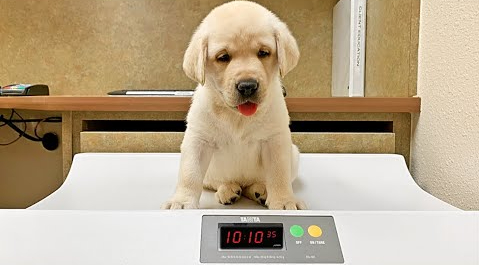Expert Tips on How to Identify Male and Female Labrador Puppy
As a prospective Labrador puppy parent, you might wonder how to identify male and female Labrador puppy. After all, knowing the gender of your future furry companion is essential for several reasons. It can influence your decision based on factors such as size, temperament, and compatibility with your lifestyle. Furthermore, being aware of the puppy’s gender allows you to prepare better for their arrival and ensure a smooth transition into your family.
However, determining a Labrador puppy’s sex is not always as straightforward as it seems. Relying on coat color or size can lead to confusion and incorrect assumptions. This article aims to provide expert tips on accurately identifying male and female Labrador puppies while dispelling misconceptions.
By understanding the differences between the two genders, you’ll make an informed decision when choosing the perfect addition to your family.
Physical Differences Between Male and Female Labrador Puppies
Before we delve into the behavioral differences between male and female Labrador puppies, let’s first explore their physical distinctions. Understanding these differences will make it easier for you to identify the gender of a Labrador puppy.
✔Examining the Genital Area
One way to distinguish between male and female Labradors is by examining their genital area. This method is the most accurate and reliable means of determining their sex.
Male Puppies: Penis and Scrotum
In male puppies, the penis is enclosed in a sheath below the belly and closer to the tail. The scrotum, which houses the testicles, is just behind the penis. For example, when looking at a male Labrador puppy, you’ll notice a small bump below the anus, the scrotum, and the penis sheath is slightly further down.
Female Puppies: Vulva
A female puppy private area has a vulva, which appears as a small slit or opening located further up the belly, closer to the hind legs. When comparing the genital area of a male and female puppy, the vulva is generally more challenging to spot than the penis sheath, especially in young puppies.
✔Differences in Size and Weight
Labrador puppies exhibit differences in size and weight based on their gender. While there is some variation among individual puppies, these general trends can help you identify their sex.
Male Puppies: Generally Larger and Heavier
Male Labradors tend to grow larger and heavier than their female counterparts. Even as puppies, males usually have a more solid build and may appear slightly larger than females of the same age. For instance, a male puppy might have a broader chest and more muscular legs compared to a female of the same litter.
Female Puppies: Smaller and Lighter
Female Labradors are generally smaller and lighter than male labs. They often have a more delicate build, narrower chests, and slimmer legs. Although these differences may be subtle, they can still offer clues when determining a puppy’s gender.
✔Coat Color and Markings: Not Always Reliable
It’s essential to note that coat color and markings are unreliable indicators of a Labrador puppy’s gender. Both male and female puppies can have the same coat colors – black, chocolate, or yellow. However, some breeders and dog enthusiasts believe there might be subtle differences in coat shades and markings between the two genders.
Male Puppies: Darker Shades, Bolder Markings
Some argue that male Labrador puppies may have slightly darker coat shades and bolder markings than females. For example, a male black Labrador puppy might have a deeper black coat, while a female could have a softer black hue.
Female Puppies: Lighter Shades, More Subtle Markings
On the other hand, female Labrador puppies have lighter coat shades and more subtle markings. Using the same example, a female black Labrador puppy might have a slightly softer black coat than her male counterpart.
Remember that these differences in coat color and markings are not definitive indicators of a puppy’s gender. It is always best to rely on examining the genital area and considering size and weight differences for accurate identification.
Behavioral Differences Between Male and Female Labrador Puppies
Now that we’ve covered the physical differences between male and female Labrador puppies let’s delve into their behavioral distinctions. While individual personalities can vary greatly, some general trends in temperament are observed among male and female puppies. By understanding these tendencies, you can better anticipate the kind of companion your Labrador puppy will grow up to be.
🐶Temperament Variations
Labrador puppies, regardless of gender, are known for their friendly and outgoing nature. However, subtle differences in temperament between male and female puppies might influence your choice depending on your preferences and lifestyle.
Male Puppies: More Dominant, Independent, and Territorial
Male Labrador puppies display more dominant, independent, and territorial behaviors than females. For example, a male puppy might be more assertive when playing with other male or female dogs or more protective of his food and toys. This dominance can sometimes translate into stubbornness during training, but male Labradors can be just as trainable as females with patience and consistency.
It’s important to note that neutering a male puppy can significantly reduce these dominant and territorial tendencies, making them more docile and easier to manage. If you’re considering a male Labrador puppy, discuss the benefits of neutering with your veterinarian to determine if it’s the right choice.
Female Puppies: More Affectionate, Sensitive, and Submissive
Female Labrador puppies are more affectionate, sensitive, and submissive than their male counterparts. For instance, a female puppy may be more inclined to cuddle with you on the couch, be more intuitive about your emotions, and be more willing to please.
These traits can make female Labs seem easier to train, as they may be more attuned to your commands and eager to earn praise.
🐶Trainability Differences
Labrador puppies are known for their intelligence and trainability, but there can be some differences in the ease of training between male and female labrador retrievers. Understanding these distinctions can help you better prepare for training and set realistic expectations.
Male Puppies: May Be More Stubborn and Require Consistent Training
Male Labrador puppies can sometimes be more stubborn and independent, which might make training slightly more challenging. For example, a male puppy might take longer to grasp the concept of housebreaking or be more resistant to learning new commands. However, with patience, consistency, and positive reinforcement, male Labradors can be just as trainable as females.
Establishing a strong bond with your male puppy and using a firm yet gentle approach during training sessions is important. It will help your pup understand that you are the leader and that following your commands will result in rewards and praise.
Female Puppies: Often Easier to Train, Quicker to Mature
Female Labrador Retrievers are generally considered easier to train due to their quicker maturation and eagerness to please. For instance, a female dog might pick up on housebreaking rules more rapidly or learn new commands with fewer repetitions. Their sensitivity makes them more attuned to your emotions and reactions during training sessions.
However, it’s essential to remember that each dog is an individual, and there will always be exceptions to these general trends. Consistency and positive reinforcement are key to successful training, regardless of your puppy’s gender.
🐶Socialization Differences
Socializing your Labrador puppy is crucial for its overall development and well-being. While Labrador Retrievers are generally friendly and sociable, there can be differences in social behavior between male and female Labs.
Male Puppies: May Be More Aggressive Towards Other Males
Male Labrador puppies can sometimes exhibit more aggressive behavior towards other male dogs, especially if the owner hasn’t neutered them yet. This aggression can stem from their instinct to establish dominance and assert their position in the pack hierarchy. For example, a male puppy might growl, bark, or even engage in physical altercations with other male dogs during playtime.
Mitigate this aggressive behavior by socializing your male puppy early on with various dog breeds, sizes, and genders. Neutering your male Labrador can also significantly reduce aggression and make them more friendly with other dogs.
Female Puppies: Tend to Be More Social and Get Along Well with Other Dogs
Female Labrador puppies generally display more social behavior and tend to get along well with other dogs, regardless of gender. For example, a female puppy might be more inclined to initiate play with other dogs at the dog park or show less aggression when meeting new canine friends.
It’s still vital to socialize your female Labrador puppy with different dog breeds, sizes, and genders early to ensure that they develop into well-rounded, confident adults.
Tips from Experts on How to Identify Male and Female Labrador Puppy
Now that you know the physical and behavioral differences between male and female Labrador puppies, let’s explore some expert tips on accurately identifying their gender. These tips will help you make an informed decision when choosing your new furry family member and ensure you’re up for the challenges and joys of raising a Labrador puppy.
👉🏻Visiting a Veterinarian or Breeder for Assistance
If you’re unsure about determining the sex of a Labrador puppy, don’t hesitate to seek assistance from a trusted veterinarian or breeder. These experts have extensive experience handling puppies and can accurately identify their gender by examining their genital area. For example, during a routine check-up, your veterinarian can confirm your puppy’s sex while assessing their overall health and well-being.
Additionally, reputable breeders are knowledgeable about the puppies they’ve raised and can provide valuable insights into their personalities and temperaments, further informing your decision.
👉🏻Have a Vet Perform DNA Testing for Accuracy
In some cases, you might want to confirm the sex of your Labrador puppy with absolute certainty, especially if you’re planning on breeding or participating in dog shows. One way to achieve this is by having a veterinarian test your puppy’s DNA.
DNA testing is a non-invasive procedure that involves collecting a sample of the puppy’s cheek cells using a swab. The specialist sends the sample to a laboratory for analysis, and the results can accurately determine the puppy’s gender, among other genetic information. For example, if you’ve chosen a Labrador puppy for breeding purposes, a DNA test can provide valuable insights into potential health issues or breed-specific traits that the parents could pass to future generations.
While DNA testing is not necessary for most pet owners, it can be useful for those who require definitive confirmation of their puppy’s sex.
👉🏻Measure the Pup’s Height at the Shoulder
Although measuring the height of a Labrador puppy at the shoulder is not a definitive method for determining their sex, it can provide some clues about their gender. As previously mentioned, male Labrador Retrievers tend to be larger and heavier than female dogs, even as puppies.
To measure your puppy’s height at the shoulder, have them stand on a flat surface with their feet positioned squarely beneath them. Use a measuring tape or a ruler to measure the distance from the floor to the highest point of their shoulder blades, also known as the withers.
For example, if you’re comparing two puppies of the same age and one with a noticeably taller shoulder height, it’s more likely to be a male. However, remember that individual growth rates can vary, and this method should not be solely relied upon to determine a puppy’s gender.
👉🏻Observing the Puppy’s Behavior Over Time
While it’s essential to rely on physical indicators to determine a Labrador puppy’s gender, observing their behavior over time can also provide clues about their sex. As mentioned earlier, male puppies tend to be more dominant, independent, and territorial, while females are generally more affectionate, sensitive, and submissive.
By spending time with the puppies and observing their interactions with their littermates, you can better understand their personalities and temperaments. For example, a male puppy might display more assertive behavior during playtime, while a female puppy may be more gentle and nurturing.
Remember that individual personalities vary greatly. A dog’s upbringing significantly shapes its temperament. So, it’s essential to consider each puppy’s unique personality.
👉🏻Engaging in Playtime to Observe Interactions with Other Dogs
Another way to identify the gender of a Labrador puppy is by engaging them in playtime and observing their interactions with other dogs. It can provide valuable insights into their social behavior, which might hint at their sex.
For example, during playtime at a dog park or a puppy socialization class, a male Labrador puppy might display more assertive or dominant behavior towards other male dogs. In contrast, a female puppy may be more friendly and get along well with dogs of both genders.
Remember that these behavioral differences are general trends, not definitive indicators of a puppy’s gender. It’s crucial to combine these observations with the physical differences discussed earlier to accurately identify the sex of a Labrador puppy.
Frequently Asked Questions
Q: When can I determine the gender of my Labrador puppy?
A: As a proud new Labrador puppy owner, you’re probably wondering when you can determine your furry companion’s gender. While it might be difficult to determine a puppy’s gender in the first few weeks of life, you can expect to see changes around the age of six to eight weeks.
At this point, the puppy’s genitals will develop, and you can tell whether you have a male or female dog. But in the meantime, don’t worry too much. There are plenty of other ways to bond with your new puppy while you wait for this exciting milestone!
Q: Can you tell if a dog is male or female by face?
A: We’ve all been there: you see a cute pup walking down the street and immediately start wondering about its gender. As it turns out, it’s not always easy to determine the sex of a dog just by facial features. While certain breeds may have more distinct features in male or female individuals, like stronger jaws or wider muzzles, there’s no guaranteed way to know.
But there’s nothing wrong with not knowing! As long as you’re giving the pup some love and attention, they won’t mind what gender you assume they are. And who knows, maybe they’ll surprise you with an unexpected and unique personality!
Q: Should I choose a male or female Labrador puppy?
A: Deciding to add a new furry friend to your family is a big step, and choosing the right one can be challenging. Regarding Labrador puppies, you may wonder whether you should go with a male or female. It’s a common dilemma, but the truth is that there’s no one-size-fits-all answer. It depends on your personal preferences and lifestyle.
Are you looking for a more mellow companion or a playful pup who will always be up for a game of fetch? Do you have other pets at home? These are just a few of the factors to consider when making your decision. Ultimately, you want a Labrador puppy who will fit in seamlessly with your life and bring you endless joy, regardless of whether they’re a boy or girl.
Final Words
Knowing the gender of a Labrador puppy is crucial for several reasons, including future care, training, and compatibility with your lifestyle. By accurately identifying the sex of your potential furry companion, you can better prepare for their arrival and ensure a smooth transition into your family. It’s essential to remember that while there are general trends in physical and behavioral differences between male and female Labrador puppies, individual personalities can vary greatly. Factors such as upbringing, training, and socialization significantly shape each puppy’s unique character.
When choosing the perfect addition to your family, it’s important to consider not only the puppy’s gender but also its personality and how it aligns with your preferences and lifestyle. Doing so will make you more likely to find a loyal, loving companion that will bring joy and happiness to your home for years to come.
We hope this guide has provided valuable insights to help you make an informed decision when selecting your new Labrador puppy. If you have any further questions or personal experiences, please feel free to comment below. We’d love to hear your thoughts and engage in a meaningful discussion with fellow Labrador enthusiasts.










